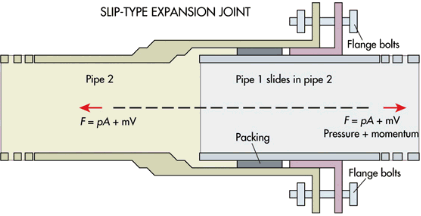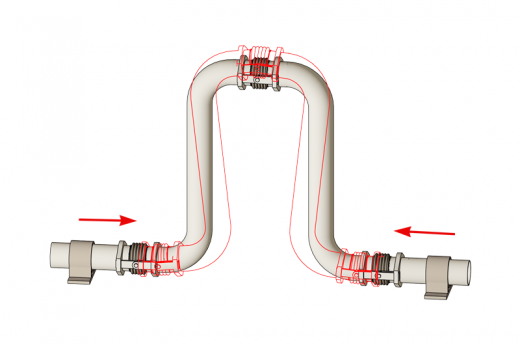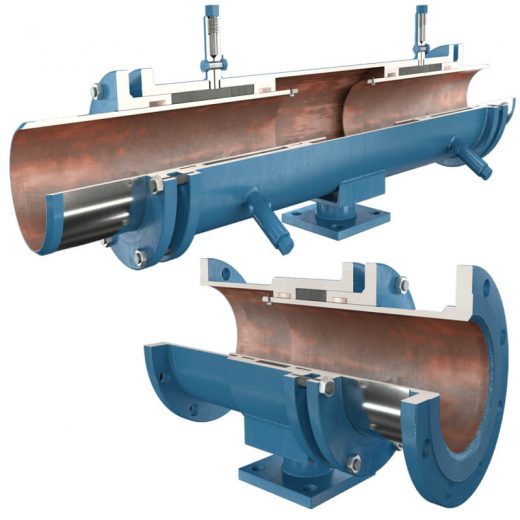Reasons behind thermal expansion and contraction in piping systems
One of the most powerful dynamic forces acting on piped services is thermal expansion and contraction. All piping materials expand or contract when pipes are exposed to higher or lower temperatures than the installation temperature. If a pipe run is fixed at both ends and heated, the expansion of the liner pipe due to temperature change will cause compressive stresses in the pipe material. If the resulting stress is strong enough to exceed the pipe material’s allowed stress, the pipe, supports, or piping components may be damaged. Depending on the extent of the damage, the facility may be forced to shut down for a period of time to make repairs or replace the piping system. Because piping systems frequently transport hot fluids, piping stresses and flexibility analysis must be carefully executed to minimize difficulties.
Design Factors To Consider
To design for pipe expansion or contraction, one must first understand the pipe material properties listed below:
- Material of the pipe — Different materials expand at different rates. As a result, the expansion coefficients of various types of plastic pipe and the metal pipe would differ.
- Pipe’s length — The longer the pipe runs, the more it expands and contracts.
- Temperature Variations – It indicates the temperature range to which the pipe will be subjected or the difference between the coldest and hottest temperatures to which the pipe will be subjected.
- Elasticity Modulus – When a force is applied, the pipe material’s intrinsic attribute expresses its ability to elongate or compress.
- Working Stress – Without losing structural integrity, all piping materials can resist some movement.
- Coefficient of Linear Expansion – Every material has a coefficient of linear thermal expansion, which states that it will expand by X amount for every degree of temperature change. The amount of linear pipe expansion due to each unit change in temperature is provided by this parameter. Varying materials have different values for the thermal expansion coefficient. As a result, the amount of expansion for CS, SS, Aluminum, Copper, and Plastic pipes will change for the same length of pipe. As a result, pipe material affects thermal expansion indirectly. Empirical tests determine this coefficient on all piping materials.
- Outer Diameter of Pipe – The pipe’s ability to deflect stress is influenced by its outer diameter. For example, a 100-foot CPVC pipe that runs exposed to a maximum temperature of 120°F and a minimum temperature of 80°F will expand 1.6 inches, regardless of the pipe’s outer diameter. However, because a 1-in. pipe can deflect more stress than a 6-in. pipe, the deflection mechanism (total loop length) for a 1-in. pipe only needs to be 2.47 ft. long. A 6-inch pipe will require a 5.55-foot-long deflection mechanism in the identical circumstance.
Types of Expansion Joints in Pipes
In industrial applications, a variety of expansion devices are used. Thermal expansion and contraction induce variations in piping systems as they heat and cool. The length of the piping run, the temperature differential, and the pipe alloy all influence thermal expansion. Because this thermal expansion and contraction can put a lot of strain on the piping system, different approaches have been used to compensate. Let’s look at the most typical expansion joints used in piping systems.
Slip-Type
Slip-type joints compress when the pipe expands into them. A sleeve that slides into an outer shell accommodates this expansion. Sealing materials are wrapped around the sleeve inside the body to prevent leaking through the slip joint. Slip joints come in a wide range of forms and configurations. However, they have several fundamental flaws. Only axial movement can be accommodated by slip joints (compression and elongation). The ability of slip joints to withstand thermal stress is limited, and the packing material must be maintained and replaced regularly to avoid leakage. This maintenance is frequently neglected, resulting in income loss due to leaking steam or other media.

Fig 1: Slip-type joint
Courtesy: passuite.com
Pipe Expansion Loops
A pipe expansion loop is one of the most frequent expansion devices. Pipe sections that run perpendicular to the piping system are installed. The resulting pipe expansion loop accommodates thermal movements. Pipe expansion loops must be installed with care to ensure that the pipe, elbows, and welded joints can withstand the pressures. Pipe expansion loops don’t need to be maintained, but they take up a lot of room in the piping layout.

Fig 2: Pipe Loop Expansion joint
Courtesy: Spiroflex
Bellows Type
Metal expansion joints are the most adaptable expansion joint pipe fittings. They are made up of one or more metal bellows that are convoluted to offer flexibility. A metal bellows expansion junction combines the advantages of pipe loops and slips joints while avoiding the drawbacks of both. Expansion bellows, like pipe loops, can absorb thermal, mechanical, or seismic movement in any direction while requiring minimal maintenance. Although non-metallic joints are less expensive, they have poor temperature resistance and pressure absorbing qualities. When installed outside, metal expansion joints are more resistant to sunlight, ozone, temperature extremes, and corrosive atmospheres than non-metal expansion joints.

Fig 3: Bellows Type expansion joint
Courtesy: adscomfg.com
Designs to tackle this Problem
In order to avoid major difficulties, piping stress and flexibility analysis must be handled throughout the design stage. If left untreated, snaking pipes or tension on pipe joints could eventually lead to leaks or burst pipes, as well as all of the associated damage that a failure could entail. Hence, the piping stress and flexibility analysis can be done in the following ways:
- By using existing bends or expansion loops – Large pipe deflections can be easily accommodated by expansion loops. Amid a pipe run, expansion loops are installed. The pipe is bent into a “U” shape and restrained in the middle by a bracket. A hanger or guide is hung on each side of the pipe run, entering the U, allowing the pipe to move back and forth. The U’s entrance narrows as it expands. The U opening widens when the muscles contract. Here, the guided cantilever method is used to calculate the needed leg length.
- By utilizing expansion joints in a well-structured manner– Expansion joints are specialized assemblies that can absorb thermal expansion and contraction in pipes. This is usually a costly option that is utilized only as a last resort.
- By changing the direction of pipes– If the neighboring pipe is long enough, thermal expansion and contraction can be accounted for by putting a hanger or guiding a specified distance away from the elbow.
- By including expansion offsets– Expansion offsets are typically installed in the middle of a pipeline. When the pipe must avoid fixed structures, this deflection mechanism is used. The vertical length of the pipe, as well as each elbow, allows for some deflection. Each pipe run is set with hangers or guides. The top and bottom elbows will press in as the pipe expands, forcing the vertical length to slant to the right. The vertical pipe will tilt to the left as it contracts.
Conclusion
These mechanisms are very important in civil engineering, especially when designing pipes. Even small changes in pipe systems can bring a big difference in the design, leading to defects. If all these are known properly, money can be saved in repairing. Thus, every civil engineer must be well equipped with modern design factors, criteria, and recommendations.
References
- Delatorre, A. (2021, March 17). Types Of Expansion Joints Required In Piping Systems | Triad Bellows. Triad Bellows | Metal Bellows and Expansion Joints. https://www.triadbellows.com/types-of-expansion-joints-required-in-piping-systems/.
- Materials, Inc., L. A. (n.d.). What You Need To Know About Piping Thermal Expansion And Contraction. What You Need to Know About Piping Thermal Expansion and Contraction. https://www.blazemaster.com/blog/what-you-need-to-know-about-piping-thermal-expansion-and-contraction.
- How To Deal With Thermal Pipe Expansion And Contraction – Walraven UK. (2021, June 24). Walraven United Kingdom. https://www.walraven.com/en/how-to-guides/thermal-pipe-expansion/.
- Materials, Inc., L. A. (n.d.). How To Account for Thermal Expansion In Piping System Design | Corzan. How to Account for Thermal Expansion in Piping System Design | Corzan. https://www.corzan.com/blog/how-to-account-for-thermal-expansion-in-piping-system-design.
- How To Account for Piping Thermal Expansion And Contraction During the Design | What Is Piping. (2021, July 20). What is Piping. https://whatispiping.com/piping-thermal-expansion-contraction/.
If you have a query, you can ask a question here.


